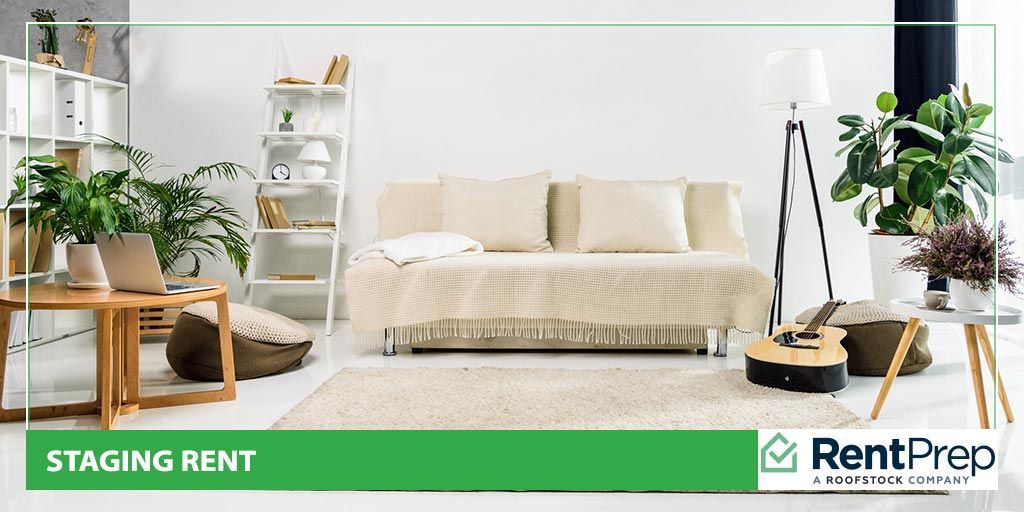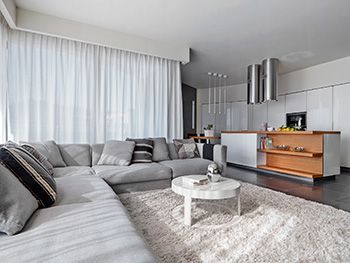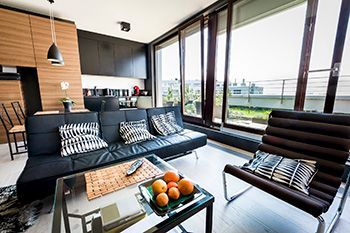
Many landlords have remained accustomed to the same type of marketing for their rentals for decades. Rental property tours and photos have showcased empty units, leaving the tenant to imagine the property as a home.
Staging rental properties shows just how much tenants want to be able to envision a cozy home rather than a cold, empty rental property. Still, landlords nationwide are learning how (and why) to stage their rentals effectively. Diving into rental staging furniture without a clear grasp of the concept can be costly and risk your ROI.
What’s the secret to staging success, and is it essential for you to start staging your rental properties? Learn more today in our complete guide on staging rentals.
A Table Of Contents On Staging Rentals
Staging for rental properties seems like overkill to some landlords, but it can effectively increase numbers (and decrease turnover). Follow along to learn more about how rental property staging helps your business:
- What Is Property Staging?
- Staging For Rental Properties: Pros And Cons
- The Basics Of Staging A Rental
- How To Succeed At Staging A Rental
- FAQs: Learn More About Rent Staging
- Stage For Success With Simple Staging
What Is Property Staging?
Property staging is the process of presenting a property with a clean and functional design to ensure potential tenants see the property’s potential. Staging aims to present the property in the best possible light. The positive parts of the property are highlighted, and the space is presented most functionally.
An essential part of staging rental properties lies in the concept of priming. Priming is a psychological method that influences people’s subconscious ideas with subtle messaging. For example, setting up a rental with a welcome doormat and other cozy signage helps potential tenants envision their life in the rental.
Combining staging and priming allows renters to see your property in a positive light. You can attract more tenants and lower vacancy rates by putting time into these tasks.
Staging For Rental Properties: Pros And Cons
Staging comes in many forms, and the correct type of staging depends on the market. High-end rental markets do well with complete staging as potential tenants in these markets seek rentals that match their aesthetic, more so than they focus on practical issues. Less expense rentals attract tenants who tend to be more focused on affordability in function, so staging should highlight these factors.
Essentially, staging isn’t suitable for every property. Staging properties has pros and cons, and you’ll want to weigh the potential benefits before investing in staging. Let’s cover the benefits and risks of staging together.
The Benefits Of Staging A Rental
There’s a lot to love about staging! No matter how far you go with staging, every little detail boosts your unit’s rentability in certain ways.
Presents An Inviting Appearance
Staging presents an attractive appearance to potential tenants. Renters see the potential of the space, primarily when rooms are staged to showcase their potential uses. For example, kitchens with space for cooking and entertaining can be highlighted when staging.
Shows Landlord Capability
Putting effort into staging shows you care about the property, its condition, and the tenant’s comfort. Staging sets you up to be viewed positively by potential renters. Start a good relationship with tenants by staging properties.
Improves Marketing Efforts
Rental marketing becomes much more effective when strategic staging is included in your marketing photos. Most tenants start their rental searches online; staged photos ensure they see your rental units’ potential from the very beginning.
Stand Out From The Competition
Finding tenants isn’t always simple. If you’re marketing rentals in an area with a lot of competition, staging properties helps them stand out. Many landlords don’t stage rentals, but staging shows a property’s potential in a unique way. Stand out by staging your rentals in these markets.
The Drawbacks Of Staging
Like all rental management projects, there are some drawbacks to staging.
The primary complaint about staging is the same among many landlords: staging is pricey.
The financial investment of staging doesn’t make sense for every property. It can be hard to know if the return will work out, and the risk is higher when the monthly profit isn’t enough to cover the investment. Sometimes it’s better to invest in essential upgrades that will help your property stand out.
The Basics Of Staging A Rental

Is staging going to help your rental business grow? If so, it’s time to learn how to go about staging your units. Some essentials should be done when staging any property. Let’s start by covering those basics.
Step 1: Declutter
First, you’ll want to declutter the space. If previous tenants leave items behind or there are too many furniture items in the rooms, the space can feel small and crowded. Walking around and observing each room’s details should be easy without obstruction.
Step 2: Deep Clean
Deep cleaning each rental unit is essential. Do more than just wipe down counters; wipe out every nook and cranny of the unit. Every part of the rental needs to be cleaned, from cabinet shelves to refrigerator doors. Clean units are more attractive to tenants.
Step 3: Paint As Needed
A fresh coat of paint does wonders for the appearance of a rental property. Staging a property with rental furniture won’t do much good if the paint looks dingy. Improve the unit by repainting each room with a neutral, attractive color.
Step 4: Add Key Furniture Pieces
If you plan on renting staging furniture, consider which pieces are essential to highlight the function of each room. Couches, dining tables, beds, and other staple pieces should be your priority. These larger furniture pieces highlight the space available and present potential unit layouts.
Step 5: Accessorize
Finally, you’ll want to accessorize each room to highlight how to use the space. Attractive dish towels, simple art, plants, and throw pillows add hominess without personalizing the area too much. You want the rental unit to look attractive without pigeonholing the appearance into one specific aesthetic. Allow the renter to envision their lifestyle in the staged unit.
How To Succeed At Staging A Rental
The basics of staging are pretty simple, but staging successfully requires more finesse. If you want the most significant boost in staging results, follow these expert tips as you set up your rental.
#1: Focus On Identity And Function
Remember that your primary goal in staging a rental unit is to make it more appealing to renters. Ultimately, tenants are looking for a rental they want to live in. Focusing your staging on identity and function will enable this.
Here are some examples of how you can accomplish this:
- Put towels in bathroom closets to show how much space is available.
- Add essentials like pasta sauce in a kitchen pantry or clothes in a closet to showcase functionality.
- Dress outdoor areas with seating to highlight these bonus spaces.
- Add specific details to each room that show off what it can be used for.
Function is the name of the game. Focus on function and your staging is likely to be a success.
#2: Don’t Forget About Lighting
If you want your staging to be a success, tenants touring the property need to be able to see your efforts!
Don’t forget about adding lighting. Ensure all bulbs are functioning correctly, and visit the property throughout the day to determine if more lighting is needed during darker times.
Another way to improve lighting is to ensure that all windows are clean inside and out. This removes dust and debris that has built up, allowing more light to come in. Maximizing outdoor lighting is best when improving lighting at a rental unit.
Finally, add a few lamps when staging. Well-placed floor lamps add light in areas that aren’t otherwise lit properly. Consider adding permanent overhead fixtures in rooms such as kitchens and bathrooms if they aren’t already installed. Choose lightbulbs appropriate for each area so that the lighting isn’t too harsh.
#3: Consider Soft Staging
Soft staging is a great option if furniture rental near you isn’t affordable or you want to get the property marketed as soon as possible.
Soft staging is a staging method where you add basic decor to each room without using many large pieces of furniture. A living room might be outfitted with a small coffee table and some art on the walls rather than a full sofa and TV set up.
Soft staging gives form and function to rooms that otherwise blend and lack purpose. The goal is to give a nod to the potential of the space without overinvesting.
#4: Invest In Your Staging Supplies
Do you have many properties that need to be staged regularly? Landlords with dozens or hundreds of units benefit from investing in their own staging supplies to store between staging periods and working with professionals.
Utilizing the advice and services of a professional staging company is an option when you have so many units. Building this relationship will lower long-term costs and ensure that you have what you need when staging. Consider investing in these options if you are managing many properties.
Get Ready To Review Applications
With updated staging tactics, you’ll collect many new renter applications quickly. Selecting the right tenant is a different story than attracting tenants; reviewing every detail on the application to determine which tenant is a good fit can be overwhelming.
Don’t struggle with tenant selection alone; let RentPrep help. Our tenant screening services come in various packages to fit every landlord’s needs. Whether you want assistance with just background checks or want full review support, you can find what you need with RentPrep. Explore our tenant screening packages and pricing options today.
FAQs: Learn More About Rent Staging
Are you entirely new to staging rental properties? Learn more about the process with these answers to frequently asked questions.
How do you stage a rental property?
Staging a rental property involves five significant steps: decluttering, cleaning, painting, adding furniture, and accessorizing. The extent of the last two steps will vary by rental unit, but all units should be thoroughly cleaned and refreshed with paint before marketing the rental.
A lot of variety can be put into staging regarding furniture and accessories. Every room should be filled with pieces that showcase its functionality and purpose without cluttering it. Your goal is to show the rooms’ potential without overly personalizing them. All tenants who view the property should be able to envision their own life in the rental.
How can I stage a rental property cheaply?
The best way to find affordable rental staging options near you is to search online. By searching keywords such as “furniture rental for staging” and “staging rental near me,” you can find local options for these services.
The cost and availability of these services vary wildly by market. If you don’t have these details, it won’t be easy to determine if staging rentals makes sense in your area.
Once you find available staging options, ask other landlords about their experiences with these services before you commit.
How much does it cost to stage a living room?
When working with a professional staging company, all staging costs are done in two parts. First, you’ll need to pay a couple of hundred dollars for a consultation. This typically covers all rooms that you plan to have staged.
Next, you’ll need to pay the fees for each actual room staged. This can range from $400 to $1,000 per month per room. The exact fees may be higher or lower depending on the extent of the staging, the location of your property, and other work involved in the process.
What should you not do when staging a rental property?
The #1 thing to avoid when staging a rental property is over-cluttering the space. Filling a rental with too many objects will make the space appear smaller than it is, and this can cause tenants to look elsewhere. Ensure that your focus is on highlighting, not overwhelming, the space.
Stage For Success With Simple Staging
Is staging rentals the norm in your area, or could you stand out by starting with rent staging practices? Either way, incorporating some or all of the tactics discussed today can set you up for success.
Staging properties benefits many rental property landlords and investors by:
- Increasing the interest among potential tenants
- Receiving more applications from interested parties
- Streamlining the preparation process with clear plans
- Engaging with your ideal tenants more effectively
Are you ready to start improving your business with rental staging? Every landlord should try to incorporate some level of staging –where will you get started?


